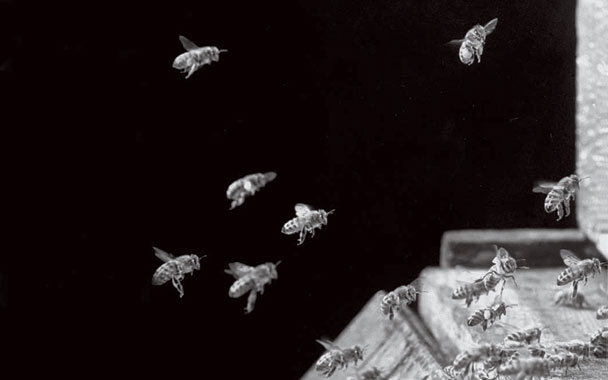My grandfather, my father’s father, is 88 years old, and as of last weekend is at death’s door. He was a teacher, and throughout my 31 years, I’ve learned more from him than I am even aware of. Just about the only thing I can learn from him now is how to let go of something you love, gracefully. His health has been steadily declining for several years, a situation that has, if only a little, lessened the impact of this inevitable final exam. But in some ways, he’s been setting me up all along, slowly teaching me how to let go, though it was only this spring that the lesson finally dawned on me.
It happened when I was out in a field on the family farm, digging a pit in which to burn the beehives that my grandfather built with his hands before I was even born. These were the same hives that he used to teach me everything I know about bees and much that I am learning about life; the same hives that for several human generations had been home to living, breathing honeybees. Those were the bees that died last year of colony collapse disorder (CCD). The same bees that my grandfather taught me to keep safe.
CCD is the name for the largely mysterious syndrome that has been killing honeybees worldwide. At this point, some experts think the cause might be a virus. The virus alone, they believe, is not enough to kill a bee, let alone a whole hive. But when combined with other viruses, predators, pests, and bacteria, the virus appears to cause a breakdown of the immune system, and the insects become unable to fight off disease. Autopsies performed on infected bees have found almost every virus, bacteria, and pathogen known to affect bee health. The hives, frames, and wax that remain after the bees have disappeared contain toxic levels of any number of diseases. It’s troubling, and some of the world’s greatest entomological minds are still baffled.
This problem flies far beyond my little apiary, from which I collect a few gallons of honey each year. It goes past the apple trees and grapevines that my bees pollinate so I can collect fruit. It is a problem that has had an impact on every almond grower in California and every peach farmer in Georgia. Each year, honeybees are responsible for the pollination of produce valued at over $21 billion. That’s huge. So huge that companies like Häagen-Dazs (a major buyer of honeybee-pollinated crops) have begun giving grants to universities and laboratories as an incentive to getting the problem figured out. Recently, another Gourmet editor and I met with a Häagen-Dazs public-relations team because they had with them a very hot commodity: Diana Cox-Foster, professor of entomology from Penn State University and codirector of the team that has been leading up the research on CCD. They were there to sell us ice cream, but they were not all smiles. In fact, when I explained how I’d found my hive empty, no one smiled at all.
It sounds like you’ve had CCD,” said Cox-Foster. I asked her what I should do. Could I reuse my hives and frames with healthy bees? No. It was her strong recommendation to destroy the hives and start fresh. That meant: Burn them. You can’t just hide pollen-packed frames in the back corner of the barn; any new bees would surely find them and, along with them, any diseases hiding in the comb.
Reusing antique frames is a point of pride for many beekeepers. Over time, the wax becomes dark golden, even chocolate-colored. The frames I was using, the frames my grandfather used before me, had become practically black. They seemed rich with history and craftsmanship, both from the man who nailed them together and from the bees that built out the honeycomb, packing it with nectar. Each time I held a frame buzzing with bees to the sun, inspecting its contents and its inhabitants, I remembered learning from my grandfather. I remembered the first time he showed me the inside of the hive.
I was 13 when my grandfather had the first of a long series of strokes. It was a minor one, and only impaired him slightly. He could still be active, he could still take care of the bees. For the first time in my life, though, I realized that he wouldn’t always be here, and that when he did go, he would be taking with him everything he knew. I wanted to spend more time with him; I wanted to learn what he knew. I could keep that part of him with me always. So I asked if he wanted help with the bees. He chuckled and nodded. I was to show up the next morning wearing long pants and a long-sleeved shirt. So I did.




 Pinterest
Pinterest






